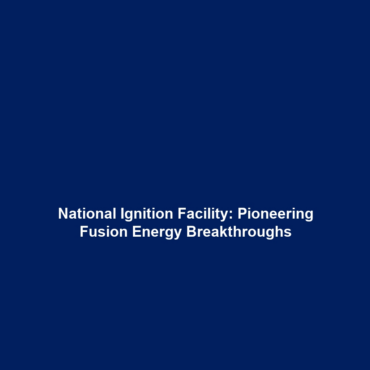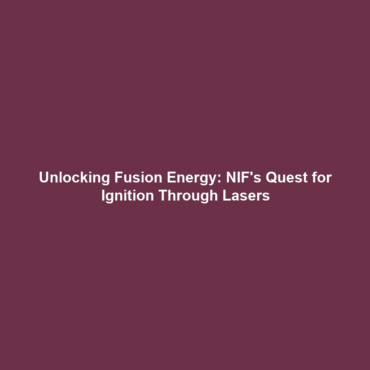National Ignition Facility: A Breakthrough in Fusion Energy
The National Ignition Facility (NIF) stands as a cornerstone in the quest for viable fusion energy. As a key research facility located at Lawrence Livermore National Laboratory, NIF’s purpose is to explore the potential of fusion as a clean, abundant energy source. With a focus on achieving ignition—that is, a self-sustaining fusion reaction—NIF plays a crucial role in advancing our understanding of fusion technology and its applications. Its significance within the broader context of fusion energy cannot be overstated, as it lays the groundwork for future innovations in sustainable energy production.
Key Concepts of the National Ignition Facility
The primary goal of the National Ignition Facility is to achieve controlled nuclear fusion by utilizing inertial confinement techniques. Here are some essential concepts that illustrate NIF’s role in fusion energy:
- Inertial Confinement Fusion (ICF): NIF employs powerful lasers to compress and heat small pellets of fusion fuel, typically composed of deuterium and tritium.
- Ignition: Achieving ignition means that the fusion reaction releases more energy than it consumes, a critical milestone for energy generation.
- Plasma Physics: NIF contributes to our understanding of plasma dynamics, which is essential in replicating stellar conditions on Earth.
Applications and Real-World Uses
The applications of National Ignition Facility (NIF) in the realm of fusion energy extend beyond theoretical research. Some notable uses include:
- Energy Generation: If successful, NIF’s research could lead to the development of fusion as a reliable and renewable energy source.
- National Security: NIF’s capabilities are vital for maintaining the safety and reliability of the U.S. nuclear arsenal without nuclear testing.
- Scientific Research: The facility is instrumental in advancing our knowledge of high-energy density physics and astrophysical phenomena.
Current Challenges of the National Ignition Facility
Despite its promise, the National Ignition Facility (NIF) faces several challenges:
- Technical Limitations: Achieving the necessary conditions for ignition remains highly complex and resource-intensive.
- Funding Constraints: Sustaining long-term research efforts in fusion energy often depends on consistent funding sources.
- Public Perception: Understanding and acceptance of nuclear fusion versus traditional energy sources can impact research advancement.
Future Research and Innovations
Looking ahead, the future of the National Ignition Facility (NIF) is filled with potential innovations:
- Advanced Laser Technology: Future upgrades to laser systems are anticipated, which could enhance energy output and efficiency.
- Next-Generation Research Initiatives: Collaborative projects with other institutions aim to explore new approaches to achieving ignition.
- Integration with Renewable Frameworks: Research may focus on how fusion energy can complement existing renewable technologies.
Conclusion
In summary, the National Ignition Facility (NIF) embodies a landmark effort in the pursuit of fusion energy. It not only aims to unlock a sustainable energy future but also plays a crucial role in national security and scientific discovery. Continued investment in facilities like NIF is essential for overcoming current challenges and realizing the transformative potential of fusion energy. For those interested in staying informed about developments in fusion technology, consider exploring additional resources about fusion energy applications and energy challenges facing the field today.



